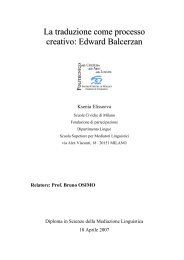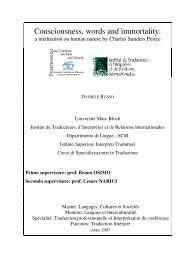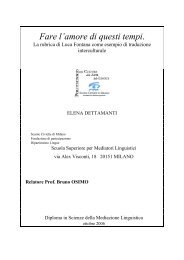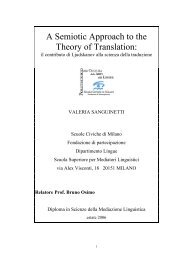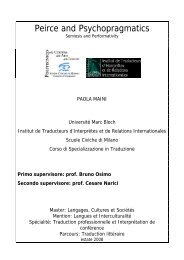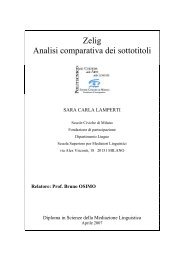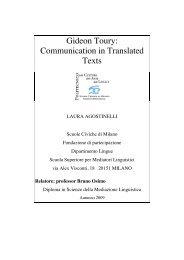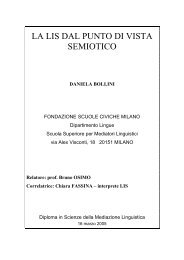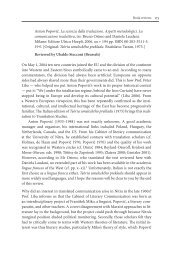Ksenia Elisseeva - Bruno Osimo, traduzioni, semiotica della ...
Ksenia Elisseeva - Bruno Osimo, traduzioni, semiotica della ...
Ksenia Elisseeva - Bruno Osimo, traduzioni, semiotica della ...
Create successful ePaper yourself
Turn your PDF publications into a flip-book with our unique Google optimized e-Paper software.
Chapter 6<br />
The Simplest Semiotic Systems and the Typology of Plots 1 .<br />
B. F. Egorov<br />
The exceptionally stormy development of semiotics has naturally brought<br />
with it study of the most diverse sign systems, and even cartomancy, fortunetelling<br />
with playing cards, has proven to be an object of research. M. L<br />
Lekomceva and B. A. Uspenskij’s innovative and intelligent essay has provided<br />
us with many valuable and interesting formulations (Lekomceva, Uspenskij<br />
1962: 84-86). However, the present study does not in fact accept one of their<br />
essay's main theses, that the system of fortune-telling «contains the potential<br />
for several interpretations» and the fortune-teller «always possesses several<br />
degrees of freedom».<br />
In the essay mentioned, emphasis is put on studying the pragmatics of<br />
the “game” for the fortune-teller and for the person having his fortune told.<br />
“Professional” fortune-telling is definitely presupposed, in which a fortune-teller<br />
conducts a game of divining past and present with his naive victim. But in such<br />
a “game”, particularly when the victim does not look at the cards or understands<br />
nothing about them, one can speak not of several but of infinite degrees of<br />
freedom. For the “professional” fortune-teller, the cards are a pure fiction, and<br />
information is received not from the cards but from the external and internal<br />
appearance of the person having his fortune told and from his reaction to the<br />
fortune-teller’s words. Even the prediction of the future is usually not obtained<br />
from the cards: a future is constructed for the victim that is capable of achieving<br />
the most “mercenary” effect, and it is based on a study of his character.<br />
1 This article appeared also in Russian as «Prostejšie semiotičeskie sistemy i tipologiâ<br />
sûžetov», in Trudy po znakovym sistemam, II (Tartu: Tartu University Press, 1965), 106-115.<br />
6



